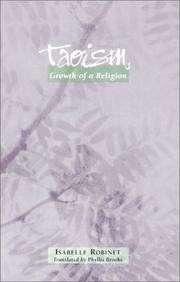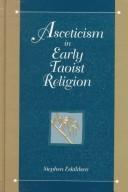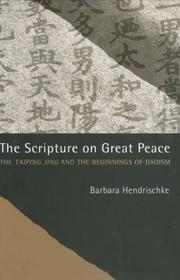| Listing 1 - 10 of 119 | << page >> |
Sort by
|
Book
Year: 1943 Publisher: Leiden E. J. Brill
Abstract | Keywords | Export | Availability | Bookmark
 Loading...
Loading...Choose an application
- Reference Manager
- EndNote
- RefWorks (Direct export to RefWorks)
Nederland --- Pays Bas --- 9 (492) " -57 : 0401 "

ISBN: 285757021X Year: 1981 Publisher: Paris : Collège de France. Institut des hautes études chinoises,
Abstract | Keywords | Export | Availability | Bookmark
 Loading...
Loading...Choose an application
- Reference Manager
- EndNote
- RefWorks (Direct export to RefWorks)
S13A/0401 --- China: Religion--Popular religion: Taoism --- Taoism
Book
ISBN: 9782070436538 9782711857371 2070436535 2711857379 Year: 2010 Volume: 558 Publisher: Paris: Gallimard,
Abstract | Keywords | Export | Availability | Bookmark
 Loading...
Loading...Choose an application
- Reference Manager
- EndNote
- RefWorks (Direct export to RefWorks)
Contrairement au bouddhisme, diffusé dans le monde entier, le taoïsme reste peu connu en Occident, sinon par le biais de ses pratiques corporelles tel le Tai Chi (taiji) ou par des traductions trop souvent déformées du célèbre Daodejing ou Tao Te King, le " Livre du Dao et de sa Vertu " attribué à Laozi (Lao Tseu). Le taoïsme est indissolublement lié à la culture chinoise, savante mais aussi populaire. Les premiers textes taoïstes connus apparaissent vers le Ve siècle avant notre ère, issus de cultes et de mouvements divers qui en viennent progressivement à former l'une des trois religions officielles, avec le bouddhisme et le confucianisme. En écartant les préjugés et les fantasmes sur les sagesses orientales, supposées radicalement différentes de notre propre expérience, Vincent Goossaert et Caroline Gyss montrent que le taoïsme, comme les autres grandes religions mondiales, est un ensemble cohérent, élaboré au cours de quelque 2 500 ans et plus que jamais vivant aujourd'hui. Il intègre à la fois une dimension mystique et individuelle, une description de l'univers, des règles morales et une vision de la société, une liturgie et des rituels, des sanctuaires et des arts - musique, peinture, calligraphie.
Taoism --- China --- S13A/0401 --- China: Religion--Popular religion: Taoism
Book
ISBN: 9781931483094 Year: 2008 Publisher: Magdalena Three pines
Abstract | Keywords | Export | Availability | Bookmark
 Loading...
Loading...Choose an application
- Reference Manager
- EndNote
- RefWorks (Direct export to RefWorks)
Taoism --- Taoists --- S13A/0401 --- China: Religion--Popular religion: Taoism

ISBN: 0804728399 Year: 1997 Publisher: Stanford (Calif.) : Stanford university press,
Abstract | Keywords | Export | Availability | Bookmark
 Loading...
Loading...Choose an application
- Reference Manager
- EndNote
- RefWorks (Direct export to RefWorks)
#SML: Chinese memorial library --- S13A/0401 --- China: Religion--Popular religion: Taoism --- Taoism --- History. --- History
Book
ISBN: 0700701133 9780700701131 Year: 1980 Volume: 1 Publisher: London: Curzon,
Abstract | Keywords | Export | Availability | Bookmark
 Loading...
Loading...Choose an application
- Reference Manager
- EndNote
- RefWorks (Direct export to RefWorks)

ISBN: 0585060096 9780585060095 0791439550 0791439569 9780791439555 9780791439562 1438402155 9781438402154 Year: 1998 Publisher: Albany State University of New York Press
Abstract | Keywords | Export | Availability | Bookmark
 Loading...
Loading...Choose an application
- Reference Manager
- EndNote
- RefWorks (Direct export to RefWorks)
Asceticism --- Taoism. --- Daoism --- Taouism --- Religions --- Tao --- Taoism --- S13A/0401 --- China: Religion--Popular religion: Taoism
Book
ISBN: 2855395534 9782855395531 Year: 1992 Publisher: Paris: École française d'Extrême-Orient,
Abstract | Keywords | Export | Availability | Bookmark
 Loading...
Loading...Choose an application
- Reference Manager
- EndNote
- RefWorks (Direct export to RefWorks)
Book
ISSN: 05674980 ISBN: 9783447108041 3447108045 Year: 2017 Volume: 110 Publisher: Wiesbaden: Harrassowitz,
Abstract | Keywords | Export | Availability | Bookmark
 Loading...
Loading...Choose an application
- Reference Manager
- EndNote
- RefWorks (Direct export to RefWorks)
In China, in the first centuries of the Common Era, prognostication was a widely used tool of political decision making, of cultural and ideological expression and, increasingly, also of popular resistance. The Scripture on Great Peace originated in this environment. It contains warnings of a universal cataclysm and suggests a radical social and religious reorientation as means of salvation. Thereby, it connects insights and ideas of the empire’s academic establishment to experiences and concerns of the population at large. It belongs to the earliest textual sources for Daoism, that is, for China’s indigenous religion that took shape when the imperial government and with it the empire fell apart in the second century CE.The present volume documents the Scripture’s doctrinal and stylistic diversity. The selected materials stem from different parts of the long text. Some focus on eschatological scenarios, others, in contrast, on utopian hopes for the reform of humankind and its future under the auspices of “Great Peace”. Still others design schemes for personal immortality. In this study, these materials are translated into a Western language for the first time. The translations are accompanied by extensive explanatory annotations.

ISBN: 9780520247888 0520247884 Year: 2006 Volume: 3 Publisher: Berkeley : University of California Press,
Abstract | Keywords | Export | Availability | Bookmark
 Loading...
Loading...Choose an application
- Reference Manager
- EndNote
- RefWorks (Direct export to RefWorks)
This first Western-language translation of one of the great books of the Daoist religious tradition, the Taiping jing, or "Scripture on Great Peace," documents early Chinese medieval thought and lays the groundwork for a more complete understanding of Daoism's origins. Barbara Hendrischke, a leading expert on the Taiping jing in the West, has spent twenty-five years on this magisterial translation, which includes notes that contextualize the scripture's political and religious significance. Virtually unknown to scholars until the 1970s, the Taiping jing raises the hope for salvation in a practical manner by instructing men and women how to appease heaven and satisfy earth and thereby reverse the fate that thousands of years of human wrongdoing has brought about. The scripture stems from the beginnings of the Daoist religious movement, when ideas contained in the ancient 'Laozi 'were spread with missionary fervor among the population at large. The Taiping jing demonstrates how early Chinese medieval thought arose from the breakdown of the old imperial order and replaced it with a vision of a new, more diverse and fair society that would integrate outsiders--in particular women and people of a non-Chinese background.
| Listing 1 - 10 of 119 | << page >> |
Sort by
|

 Search
Search Feedback
Feedback About UniCat
About UniCat  Help
Help News
News